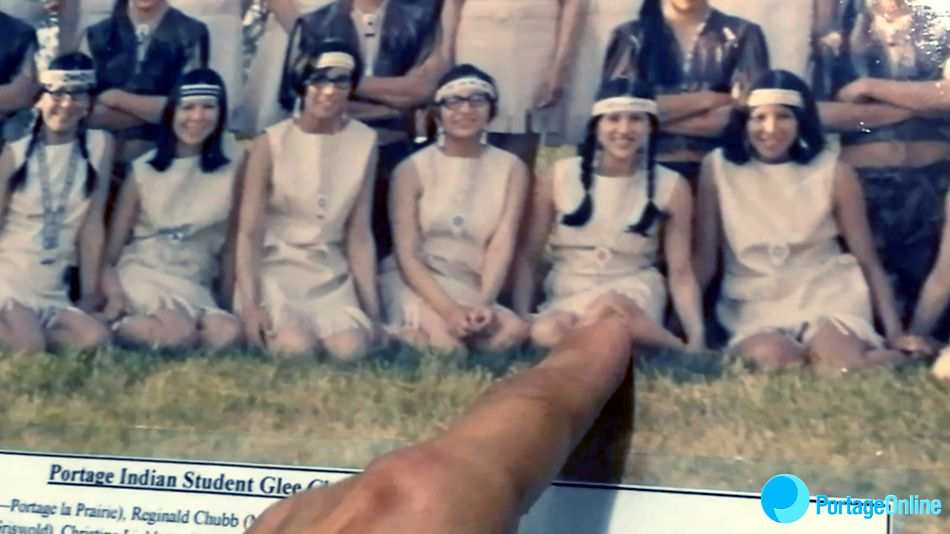The National Indigenous Residential School Museum in Keeshkeemaquah Village, near Portage la Prairie, has opened its doors for tours while they're still developing further displays.
Lorraine Daniels took PortageOnline for a tour and says it's the former Portage la Prairie Indian Residential School; now a national site.
 Lorraine Daniels in Glee Club photo of trip to Osaka, Japan
Lorraine Daniels in Glee Club photo of trip to Osaka, JapanThe tour started in a room that was originally where the girls' playroom and common area was located.
"This room was also dedicated to a young girl that passed away here," says Daniels. "Her name is Bernadette Hart."
The next two rooms focused on pre-residential school times and display artifacts that have been collected through the years.
Daniels says artifacts are from collection efforts as well as donations.
 Healing shoes made from mud from actual grounds of residential schools
Healing shoes made from mud from actual grounds of residential schoolsYour attention is drawn to a photo of John Daniels who was a long-distance runner.
"He was also messenger," says Daniels. "He is from the Long Plain First Nation and he would send messages and relay messages all the way from the Interlake area, right down to Belcourt, where he had relatives."
The photo shows him in front of a house where she, herself, lived until she was seven years old before she went to a Residential School
Daniels says there is a jacket in the room that was donated from a man who ministered to the Indigenous people up north.
"It's very heavy. This is wolverine (fur) that you see around the hood and sleeve-ends. Inside is Beaver pelts," explains Daniels. "It's very heavy. We will be receiving another one similar to it."
 Newspaper clippings from Europe about residential schools
Newspaper clippings from Europe about residential schoolsShe says there is a "tikinagan" that mothers wore when carrying their babies. It looked like a board with leather arranged for the baby to be held inside comfortably.
"In the tikinagan and a smaller one is a moss bag where they would keep the little ones in -- it's like a tikinagan but smaller."
The rooms that focused on life in the residential schools showcased an actual bed from that era in which Indigenous children slept.
"When they first enter the residential school, they get off the bus and they take them into a room," says Daniels. "They cut their hair. Once their hair is cut, they put DDT in their hair, which is a banned pesticide, and they would have to wear a towel overnight. In the morning, they would have to wash their hair out because everyone was suspected of having lice that came into the residential schools. Hair was very sacred in our culture. So, it's like taking the Indian out of the child."
Daniels says she attended school in Sandy Bay and showed photos of the structures.
"Those are the three resident schools that I attended at the end of the year in Sandy Bay. You were given a little bag and they would give you, maybe, two sets of clothing. You had the shoes you came to school in, and the pair that you had at school. Most of the schools had uniforms. You you probably had an outfit for church, and two sets of play clothes all year long."
One room was dedicated to the 215 unmarked graves discovered in Kamloops.
"Long Plain First Nation had a ceremony to honour the children," notes Daniels. "The wreath was commissioned as part of Jordan's Principle. A lady also was commissioned to do the blankets with 215 feathers and the jingles to represent the children that were missing."
 Victims of plane crash in Winnipeg
Victims of plane crash in WinnipegOne room had a much brighter story about their time in a school. It highlighted a trip the students took as part of a singing group.
"They went to different towns and cities across Canada, and they also went as far as Texas and California, and sang. They had a Glee Club. Jack Harris was the administrator back then. He was very sports-minded, so he had the students participate in sports in the community and started a Glee Club. I didn't go to this particular school, but I joined the Glee Club. I was already living in a private home and was there from grade 10 to 12 in Portage la Prairie, and lived with a family. I had the opportunity to attend. A lot of these kids were from up north, Sioux Valley and Long Plain. And I'm in this picture. And the gentleman that was our music conductor, on the right-hand side in the blue jacket, is Gordon Billows. He was our music conductor. And Marine Blight was from Oakville. She was our pianist."
They actually made a trip to Osaka, Japan.
"We were there for two weeks and toured and sang at the Canadian Pavilion in Osaka."
"They also have a record and this is the record that they produced," says Daniels, as she points to the vinyl record case. "There is also another record. We sang at the Centennial Concert Hall. And when Pierre Elliott Trudeau was the Prime Minister, we had, I think it was 1970, the Queen come. We were able to see her when we came back from our trip."
One of the last rooms in the tour was the common area for boys.
"They had the TV and lockers in the room," notes Daniels.
She points to a display.
"This is a very sad story about an intergenerational survivor and how he had seen things, trying to understand," adds Daniels. "And how he has forgiven his parents and his grandparents. He had attended residential school."
The display room has photos of many hockey players from the schools, who were mostly from Long Plain and Swan Lake. Another display in the room included a group of students who were killed in a plane crash in Winnipeg.
"They were on their way home in 1972 and the pilot, and all the students, perished," notes Daniels. "I think there is going to be a memorial for them this coming year in Winnipeg. And Iona Weenusk was an up-and-coming short-story writer. She did some poetry and she talks about how difficult it was to live in two different worlds. She came from up north and lived down here, and she had a hard time adjusting. She also won a few awards for the story she wrote in the Winnipeg Tribune and the Winnipeg Free Press."
As the tour comes to a close, a room showcases the theme of taking their culture back, with dance dresses in display. Then the tour ends with the Room of Reflection. She notes it's a relaxation room with a television and couches.
"For some, it's a very difficult tour," says Daniels. "The truth has to be told, and sometimes, it's very difficult for people to process it. So, we created this room where they can come and debrief, just reflect, and not take anything home but leave it here. And we're hoping down the road that we can have an in-house counselor, a therapist, on hand. We're also collecting different art from individuals. And so, this will be a room of comfort."











